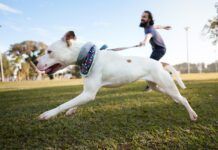Believe me, Im not a dog trainer, but I do get to play one … not on TV, of course, but behind the scenes of WDJ. Because I assign and edit the articles, and take most of the photos that accompany the articles, I have to completely understand and be able to illustrate what our expert authors discuss.
I often rely on one of the many talented positive dog trainers in my area to demonstrate for my camera the principles and practices described by our authors most frequently our Training Editor, Pat Miller. But sometimes the article begs for a non-professional trainer an ordinary dog owner. In that case, I have to be able to describe and demonstrate the articles principles to my models, who are often my more-or-less willing family, friends, and neighbors.
So, in order to assign, edit, and illustrate WDJs training articles, I find myself playing trainer with my own dog, as well as dogs belonging to everyone I know. But of course, Im not a real trainer, just a highly interested, motivated, and knowledgeable amateur. And, as with most amateurs, I sometimes get in over my head as I seek to put my knowledge into practice.
Problems in the park
This occurred recently, as I was dog-sitting Hannah, my brothers big dog, for a fort-night. As I strove to help Hannah understand the rules in my home and home office, and supply the fit young dog with ample opportunities to exercise, I found myself spending a lot of time training her. And at least once a day, I found myself getting stuck perplexed about how to best deal with something or other, despite my having paid deep attention to seven years worth of articles about training written by some of the best positive trainers in the world, and attendence at numerous training seminars and conferences!
Take, for example, the morning I found myself yanking on Hannahs leash quite angrily and punitively, after her sudden charge toward a squirrel she sighted across the park (seemingly) threatened to rip my arm out of its socket. I was really mad for about three seconds. Then the shocked, hurt expression on Hannahs face brought me up short. Oh my goodness! I thought to myself. Im the editor of the Whole Dog Journal, a leading advocate for nonviolent training methods, and Im yanking this dogs leash! What the heck am I doing?!(Well, Im human. And Hannahs impulsive dash took me by surprise, scared me, and hurt! These are not excuses, mind you; just explanations.)
My next thought was, I wish I could have a private training session with Pat, so I could see how she would handle this!
Consultation is invaluable
The more I thought about it, the more I liked the idea of having a professional trainer like Pat coach me through some specific issues with Hannah. WDJ has given me a very good theoretical understanding of how to train dogs in an effective and humane manner, but I am sometimes at a loss as to how to deal with a specific aspect of training or handling in a real-time application.
Pat lives and trains on a gorgeous farm-based facility in rural Maryland, and Im in California, so an in-person consultation was out. But we cooked up the following photo spread as a way to accomplish two things: help me with the problems I was having with Hannah, and possibly help some of you, who may be struggling with similar issues with your dogs. I imagine that many of you are like me increasingly educated about training but still able to benefit from direction when actually practicing with your dog.
There is no substitute for a personal consultation with a trainer. But while private, personal lessons are ideal, telephone consultations can also be incredibly helpful. Pat has provided me with invaluable guidance on numerous occasions via telephone or e-mail. This format a written and photographic description of the problems Hannah and I were having proved to be even more useful.
I had my brother, Keith, take pictures of Hannah and me on a walk. After sending them to Pat, I asked her for suggestions regarding what I saw as the biggest challenges to safety and enjoyment while walking Hannah: her frequent pulling; her occasional strong lunges toward squirrels and fascination with them; her aroused behavior when passing other dogs (and sometimes just people); and her occasional fear of something or someone on the street. Ive used many techniques that Pat and our other expert trainers have described in past articles, and had much success, but Pats suggestions helped me be even more effective.




